The October AXN Director’s Chair features Lew Bleiweis, executive director at Asheville Regional Airport (AVL). Below is an excerpt from the interview.
In the mountains of western North Carolina, Asheville Regional Airport (AVL) is facing some challenges. The number of passengers using the airport is rising dramatically, creating some of those good-to-have problems facing many airport directors around the country. AVL served just under a million passengers in 2017. This year, the growth rate tracked above 20 percent for the first six months, suggesting a record-breaking result for the year if things continue on the same course.
Lew Bleiweis, executive director at AVL, is navigating the increased demand with plans for new infrastructure to help deal with the passenger surge. Bleiweis spoke with AXN’s Carol Ward about the latest developments at AVL and about challenges facing the nation’s airports.
Ward: You’ve seen very strong growth recently. What’s going on?
Bleiweis: We’ve seen almost 50 percent growth in our traffic over the past four or five years. It’s been phenomenal for our community as we’ve seen a lot of tourists coming to town. It’s been going really well, so well that we’re starting to have constraints on our terminal facilities. We are looking at some projects coming up in the next year or two to give us some additional room in our terminal, to be prepared for continued growth. Last year we were up roughly 15 percent, and so far this year, we’re up about 25 percent.
Ward: What’s your current situation with regard to terminal capacity, and what are you planning to do?
Bleiweis: We’re not sure yet – we’re working with consultants now to figure out the best way forward. We’re just finishing up a terminal infrastructure assessment. A lot of the terminal infrastructure is original, so 50 to 60 years old. We’ll go over the consultant report and determine the next step. Do we renovate? Do we add on to the existing terminal? Or do we look at doing something totally different? If we continue to grow at the pace we currently are, we’ll be bursting at the seams until we can do something with our terminal.
Ward: With all the growth, how are your concessions performing? Do you have any changes in the works?
Bleiweis: Our concessions are doing well. They’re setting record revenues themselves as the growth continues. Paradies Lagardère has all the concessions – it’s a small program. They’re going to be adding an Auntie Anne’s and Cinnabon cafe. They’re bringing in more of what our passengers are looking for, so we’re excited about that. Paradies has another two or three years left, and at least one extension for five years.
Ward: Do you have any other revenue generating initiatives underway?
Bleiweis: We’re working on trying to develop some of our non-aeronautical-use land. We’ve got roughly 200 acres that could be developed. We’ll be issuing a [Request for Proposals] looking for land developers who want to do some development around the airport. We also currently work with Western LLC, a third- party aviation developer, to try to develop our aeronautical land.
Ward: On a broader scale, what do you see as the biggest issue currently facing the broader airport community?
Bleiweis: There are two big ones. Funding of capital projects is still a huge issue for airports. We are still dedicated to try to push Congress to increase the [passenger facility charge] cap for capital projects. The other thing is dealing with the pilot shortage. We’re seeing a lot of new air service being put in place, but for new air service to come into play, someone else has to lose it.
Ward: On the PFC front, the battle has been going on for many years. Do you think exploration of another funding mechanism is in order?
Bleiweis: I’m only one individual on the executive team at [Airports Council International – North America]. We are looking at other options. We don’t want to put all our eggs in one basket, so we are looking at other possibilities to provide the necessary capital for airports to grow as the economy continues to grow. My state of North Carolina has been very instrumental. The legislature has been very helpful to commercial service airports. A year or so ago, they put in some additional funding that could be used as a model for other states on how to provide additional funding. There is more happening on the state level [nationwide].
Editor’s note: The full version of this article appears in the October 2018 issue of AXN Magazine. Click here to subscribe.







